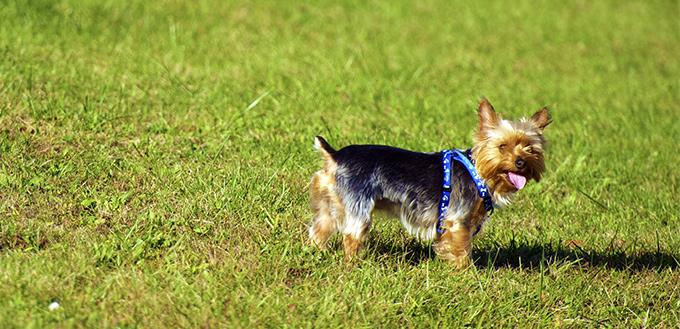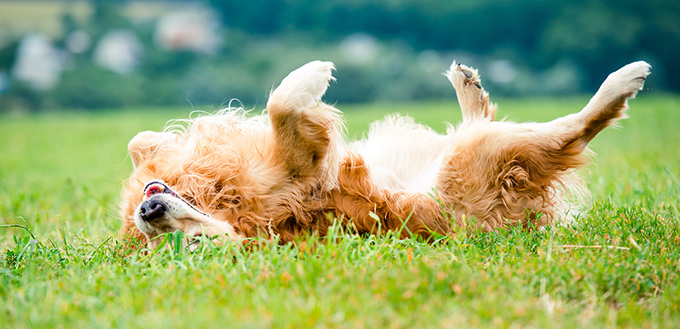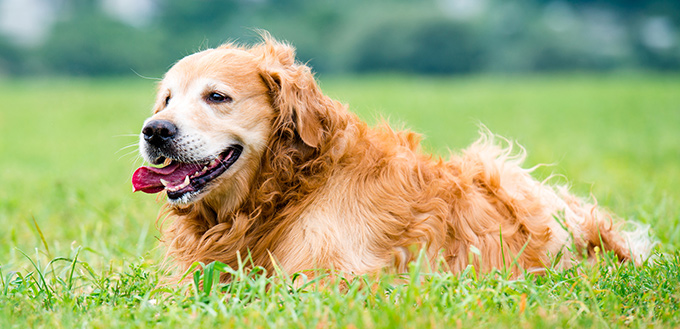Most people have had dandruff at some point in their lives. Those white flakes on your collar and shoulders can be a little embarrassing, but mostly, it’s easily treated. But it’s not just people who get dandruff. Dogs can have dandruff too. They probably don’t feel embarrassed by it, but it can definitely be irritating, and painful.
What Is Dandruff?
Dandruff is a condition that affects your dog’s skin. Flakes of dead skin cells will appear in his coat and hair. The flakes won’t bother your dog, but itching, irritation, hair loss, and further issues such as skin infections are also common with dog dandruff. Your dog may be very annoyed and agitated by these secondary conditions of dandruff. If you think your dog has dandruff, you should look for patches of hair loss and baldness. You may even find scabs, pimples, or raised areas in places affected by dandruff.

Seborrhea
Some people use the word seborrhea when talking about dandruff. You may hear people use seborrhea and dandruff interchangeably. This isn’t strictly accurate. Seborrhea is actually a cause of dandruff, and not the dandruff itself. There are two types of seborrhea – primary and secondary.
Primary seborrhea is usually considered to be a genetic condition. Secondary seborrhea is much more common in dogs. It is usually caused by allergies, or by underlying skin conditions.
This condition causes the skin cells to come to the surface before they are mature. These cells flake away as dandruff. This can also be accompanied by a greasy, oil-like substance. This substance can clump in the ears, armpits and belly. It can also have a distinctive, unpleasant odor.
Some breeds do seem to be prone to seborrhea, which would suggest a genetic link. West Highland Terriers, Basset hounds, Shar-Peis and Dachshunds are all commonly affected. Other breeds of dog can suffer from secondary seborrhea as a result of some other condition.
Causes Of Dandruff In Dogs
There’s a great number of possible causes of dandruff in dogs.
- Cheyletiella Mites
Cheyletiella mites are often referred to as walking dandruff. They can be seen by the naked eye, and look just like flakes of dandruff that move. These mites pass between animals easily, and if one dog has them, then it’s likely that any other dogs in the home has them as well.
Dogs with Cheyletiella mites will be extremely itchy, and you may notice the skin has small, red raised areas. It’s very easy to diagnose, and your vet can start a course of treatment.
- Inherited Conditions
Generally, dandruff is a secondary symptom of another condition, however, sometimes it is the primary, inherited condition. You should also be aware that there are two types of dandruff – oily dandruff and dry dandruff. Some breeds are more prone to oily dandruff, such as Cocker Spaniels, West Highland Terriers, English Springer Spaniels, Shar-peis, Basset Hounds and Labradors. Other breeds tend to have dry dandruff, such as Dobermans, German Shepherds, Irish Setters, and Dachshunds.
- Allergies
Allergies can trigger episodes of dandruff, and dry, itchy skin. However, it can be very difficult to figure out which allergen is triggering for your dog. Like people, dogs can be allergic to many things, such as chemicals, plant pollen, or dietary ingredients.
- Parasites
Parasites on or in your dog’s skin can cause an allergic dermatitis, or other skin conditions, which would result in dandruff. Fleas and mites can cause the skin to itch. Also, some types of worm infestation can result in skin irritation and dandruff.
- Endocrine Conditions
Conditions such as Cushing’s Disease, hypothyroidism, or any health issue that causes excessive urination or defecation can cause issues in the skin and dandruff. In these cases, it is extremely important that the underlying condition is treated, and managed appropriately in order to combat the dandruff and other symptoms.
- Infections
Sometimes dandruff can be a symptom of a bacterial or a yeast infection in the dog’s skin. Infections would need to be assessed by your veterinarian for treatment, as again the underlying condition needs to be treated to resolve the dandruff issues.
- Weather
Some dogs, like some people, can be very sensitive to changes in the weather and humidity. You may notice your dog suffers from dandruff and dry skin in the winter months. Lower humidity means that there’s less moisture in the air, which can dry your dog’s skin out. Some dog’s may suffer from dandruff during spring or summer, but this is more likely to be caused by other environmental factors.
- Diet
Dandruff can also be caused by a poor diet, dietary abnormalities, obesity, or severe underweight. Poor quality foods can mean that the dog isn’t getting all of its nutritional requirements, which in turn is affecting the quality of the skin.

Treating And Preventing Dandruff
How you treat your dog’s dandruff, and how you prevent it from occurring in the first place depends on the cause of the dandruff. Treating and clearing the underlying condition is paramount in controlling the resulting dandruff. If your dog suffers from recurring incidences of dandruff, you should make an appointment with your veterinarian to reach a diagnosis, and a full treatment plan.
- Grooming And Bathing
Grooming and bathing are very important in preventing occurrences of dandruff. Regular brushing helps promote oil production which keeps the skin and hair healthy. Brushing will also aid in the distribution of the oils throughout the hair, and rid the hair of contaminants from the environment.
Bathing is just as important as regular brushing, but it’s also important not to bathe your dog too often. Bathing your dog too often can cause other problems with his skin. How often you need to give your dog a bath will depend on how severe his dandruff is. In extreme cases, you may need to bath your dog with a medicated shampoo every few days until the flakes have disappeared, and skin sores have healed. When the dandruff is getting better, reduce the baths to twice a week, then once a week. If the skin is normal, and there is no sign of dandruff, you can reduce baths to once a month. Having said that, you should try to reduce the number of baths during the winter months if your dog’s dandruff is triggered by the colder, drier weather.
Check out our guides on the Best Brush for German Shepherds, Best Dog Shedding Brush, and Best Brushes for Short Hair Dogs.
You should also make sure you use one of the best medicated dog shampoos, and absolutely never use an anti-dandruff shampoo meant for people. Human products can cause further skin issues, whereas a medicated dog shampoo has been designed and formulated specifically for dogs. You also need to be aware that oily dandruff and dry dandruff need different shampoos. If your dog has dry dandruff you need to look for a product containing coal tar, selenium sulfide, or benzoyl peroxide. If your dog has oily dandruff, look for a product with sulfur, systolic acid or iodine.
- Diet
The diet often plays a huge part in skin health. If your dog is suffering from dandruff you may need to assess his diet. The quality of the food, and the nutritional composition of the food are both massively important. You need to check that your dog is getting enough essential fatty acids, and if not, you should consider adding an omega-3 fatty acid supplement to his diet. Experts say you need to add 35mg of omega-3 for every kilo of weight. You should also make sure he has constant access to fresh, clean drinking water.
You May Also Like: Dog Water Fountain
Dandruff can be a result of food allergies in the current diet. If this is the cause for your dog’s dandruff, then you may need to use the trial and error method to work out what it is he’s reacting to, and find a suitable replacement.
- Humidifier
You may find it beneficial for your dog’s skin, and for your own, to run a humidifier in your home during the winter months. The humidifier will increase the moisture in the air, so the skin won’t dry out as much, thereby reducing the risk of dandruff. Many owners keep one in the areas where the dog spends the most amount of time, such as where he sleeps.
- Spritzer
Some pet spas, and holistic pet care stores special oils designed to help soothe skin. They restore the moisture balance in the skin which can help reduce the dandruffy flakes. Many of these oils come in a spritzer so it’s easy to use.
You could also try a moisturizing natural hand cream. All you need to do is squirt some hand cream on your hands and massage it into your dog’s skin. Make sure you get in through the hair.

Natural Home Remedies
As well as using a medicated shampoo, some people like to treat dog dandruff with natural home remedies. Home remedies can be very effective in treating various ailments, including dandruff however, not every dog will react to everything in the same way. Some dogs can be sensitive to some of the ingredients, so if dandruff worsens, or the skin seems more irritated, then you should immediately stop the treatment.
- Coconut Oil
Coconut oil for dogs has seen a recent rise in popularity due to its incredible versatility. Not only can be used in cooking, but it’s also an extremely effective natural moisturizer and can help you treat your dog’s dandruff. You should mix the coconut oils with equal part water, and rub it onto your dog’s coat. You should leave the mixture to set for a few minutes, and then shampoo according to the instructions on your dog’s regular shampoo. You can do this once per week.
- Olive Oil
Olive oil is also a great natural moisturizer, but it can be used differently to the coconut oil. Olive oil can be rubbed into the skin and hair directly. Olive oil also doesn’t need to be rinsed or shampooed out of the hair. It can be used every day.
- Apple Cider Vinegar Rinse
An apple cider vinegar rinse can be very helpful in treating dandruff, irritated skin, and uncomfortable itching. It’s made from equal parts apple cider vinegar, and water. It can be used as an after shampoo rinse or as a spot treatment.
- Lime Juice Rinse
Lime juice is absolutely packed with vitamin C, and vitamin C can help treat, control and prevent dandruff. You need to combine equal parts lime juice and equal part water. Like the apple cider vinegar rinse, you can use this as an after shampoo treatment, or as a spot treatment.
- Milk Of Magnesia
Milk of magnesia has been used in treating a great number of ailments and illnesses for both people and animals. It can be used in treating dandruff, by applying directly onto the skin. It needs to be left for around half an hour and then shampooed out according to the instructions of your dog’s regular shampoo.
Final Thoughts
Fortunately, there’s a huge number of ways to treat dandruff, so your dog doesn’t need to suffer from the itching. However, the first thing you need to do is understand and treat the underlying condition that is causing dandruff. For example, if the dandruff is caused by an endocrine condition then the dog will need to start hormone replacement treatment to deal with the condition itself, as well as dandruff treatments to deal with the symptoms. If the dandruff is caused by a bacterial, or fungal infection then the dog might need antibiotics or a topical treatment. If the dandruff is caused by parasites, then these would need to be treated before dandruff can be resolved. When you treat and control the underlying condition, then your dog can enjoy a higher quality of life.






